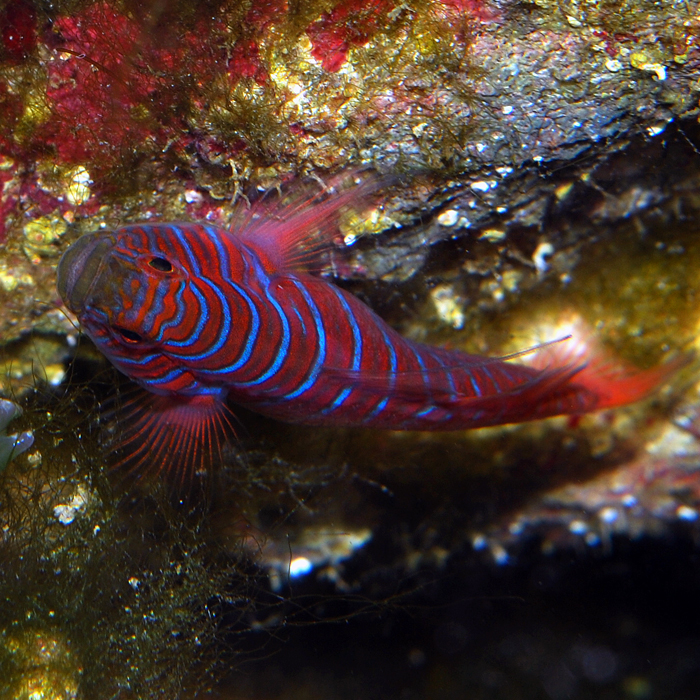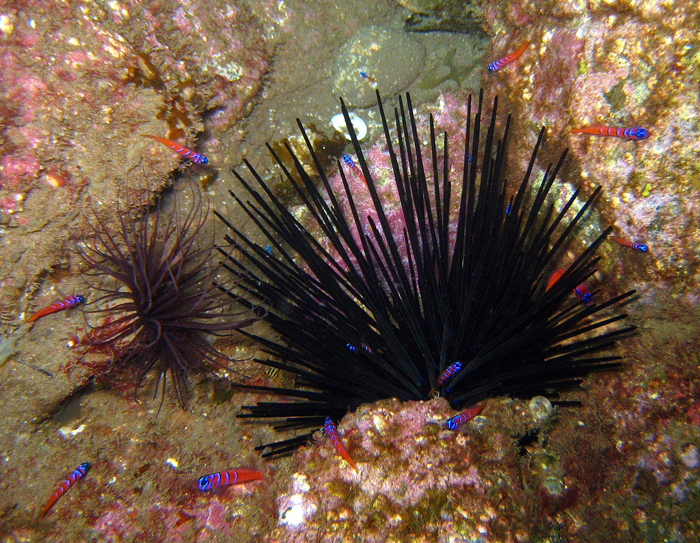The future of the aquarium hobby depends on sustainable aquarium livestock harvesting and responsible aquarium keeping. The Catalina Goby, Lythrypnus dalli, has a long history of being marketed as tropical fish or a coldwater fish that can adapt to warm water. When the gobies die shortly after purchase, it is assumed they are delicate or have short lifespans, but neither is true. They are temperate fish and quite hardy in cold water; the maximum temperature to plan for in a home Catalina Goby aquarium should be no more than 65°F, maintained by a reliable chiller.
According to fishbase.org, the maximum water temperature Catalina Gobies can be found living in is 71°F during the hottest point in summer. Keep in mind that our reef fishes can be found in waters where the temperatures reach more than 90°F in summer, but we don’t attempt to keep reef aquariums that warm. Our captive aquariums are very different from our pets’ natural habitats. Without the dilution of the vast ocean, warm temperatures can cause dangerously low oxygen saturation, increased metabolism and respiration, and aggressive growth of bacteria and parasites. Attempting to keep any fish at the very top of its natural temperature range is going to shorten its lifespan and weaken the immune system.

A Catalina Goby bred in captivity by Ken Wingerter
Public aquariums have known for years that Catalina Gobies must be kept at low temperatures. The Monterey Bay Aquarium houses Catalina Gobies in a chilled aquarium maintained between 58 and 60°F, and their Catalina Gobies’ average lifespan is 2 years. The Steinhart Aquarium keeps their Catalina Gobies at 60°F.
Catalina Gobies readily spawn in captivity. They are simultaneous/sequential hermaphrodites, meaning each goby has the reproductive tissues of both sexes but can only display one sex at a time. They are able to switch sexes back and forth when necessary. Males are larger and have a long dorsal fin with dark pigment at the tips of the long dorsal fin rays. Males lure receptive females into a cave where they will spawn, laying eggs on the walls of the cave, and then the male cares for the eggs.
There are 20 species in the Lythrypnus genus, but only the Catalina and Lythrypnus zebra are collected for the aquarium trade. L. Zebra ranges as far south as Clarion Island in the Revillagigedo Islands north to the cold waters of Caramel Bay, Central California. Zebra Catalina Gobies share most of their range with Catalina Gobies; the two species are often found living in the same area.L. zebra is considered sub-tropical and may tolerate warmer temperatures than L. dalli but thrives at lower temperatures.

Lythrypnus zebra
There are tropical gobies that rival the Catalina Gobies’ beauty and make much better additions to a reef aquarium. Gobies of the genera Trimma and Eviota are similar in size, color, and behavior. Trimma and Eviota gobies can even be kept in small groups with less aggression than groups of Catalina Gobies.
Responsibility begins with the collectors, wholesalers, and retailers, but we as hobbyists have a voice every time we purchase a specimen for our aquariums. We can educate fellow hobbyists about cold water livestock and avoid the temptation to keep them in our tropical aquariums. By avoiding difficult to keep species, we can decrease demand for these animals, and fewer of them will be collected. We all play an active role in the future of our aquarium hobby.











I would like to purchase either digital or print of all 3 photos of the Lythrypnus dalli and the Zebra Gobie as shown in you great article. These are for my home use and sharing with high school students.
In addition, I have an idea to share if you are interested to breed large amounts of them in the wild.
Ken 562 397-0999